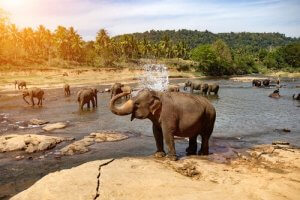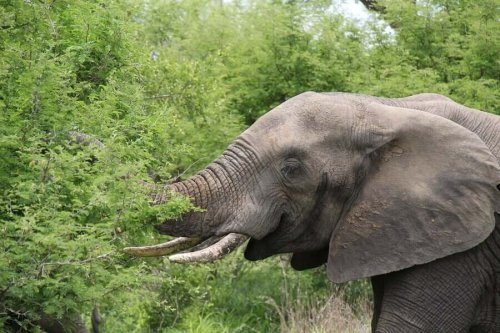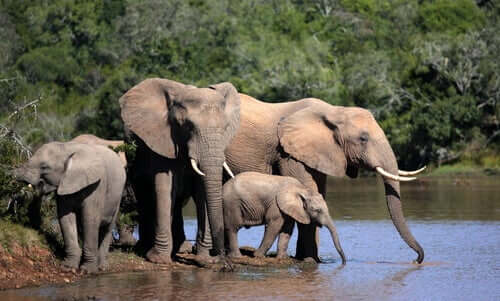The Elephant: Characteristics, Behavior, and Habitat

The elephant is one of the largest mammals in the world and, in the terrestrial realm, it undoubtedly takes the top spot. This is a species that’s a descendant of the mammoths and mastodons from the Ice Age.
This animal belongs to the group of pachyderms, which includes mammals that are herbivores, have thick and hard skin, are large, and weigh a lot. Thus, this group also includes rhinos, wild boar, and hippopotami.
The elephant and its characteristics
Beyond its size, which can exceed 13 feet (4 meters), the elephant has other very striking physical characteristics. For example, it can weigh up to one ton. When a calf is born, it usually weighs about 220 pounds (100 kilograms).
The elephant is one of the oldest animals on the planet, and can live up to 70 years. In this regard, there was a case of a specimen in captivity that died at age 86! Other highly interesting characteristics of the elephant are:
- Speed: Up to 34 mph (40 kph)
- Gestation period: 22 months.
- Reproductive age: From age 12 to 50
Its trunk doesn’t contain any bone, and is a very useful tool for elephants to collect food, make sounds, and identify smells. Their ears not only serve to detect sounds in their surroundings, but also to regulate their body temperature.

Diet
The elephant is a herbivorous animal. Their diet consists of bark and leaves of both trees and shrubs, as well as herbs and fruits. It needs to feed for 16 hours a day to be able to survive. This means it can consume up to 551 pounds (250 kg) of food throughout this time.
The elephant’s body can process only 50% of what it eats. Hence, it needs to feed slowly and progressively. However, to complete its diet, the elephant needs to rehydrate. In fact, it can drink up to 15 liters of water at once.
It should be noted that elephant calves spend up to four years feeding only on breast milk to grow and develop properly. Thus, this animal develops slowly but surely.
Behavior
The elephant groups in herds with a matriarchal organization. In other words, the herd consists of young females and calves and is guided by the oldest female. Herds don’t usually rotate their members and recognize each other for the rest of their lives. Males are independent except when they mate.
When a specimen is already too old or sick, the herd tries to help it get up until the animal no longer can hold itself up. Then, the herd groups around it to try to help it. Once it dies, the other elephants manifest different behaviors, such as:
- Raising their trunk while remaining standing in a posture that denotes tension
- Caressing the body with its trunk and throwing dirt, leaves, or branches on the remains
- Staying with the body until it begins to decay
This animal keeps a constant and positive interaction with its herd. Females are particularly sociable with each other and usually show a lot of empathy. Also, they have a great sense of cooperation and fellowship, and try to protect each other.

Habitat
Elephants usually always live near a source of water. Not only for drinking but also for bathing, as it allows them to protect their skin from the sun and heat. These mammals love to wallow in the mud and spray dust on themselves to counteract the effects of sunlight or insect bites.
The elephant needs a lot of space, and doesn’t usually stay in the same place for long periods of time. These animals are nature’s gardeners. When they migrate, they disperse seeds and this promotes the growth of vegetation in different areas.
Now, depending on the species, the landscape varies. For example, African elephants live in tropical forests, grasslands, river valleys, swamps, and savannas, while Asian elephants live only in tropical forests. However, nowadays, many elephants have had to be placed in sanctuaries and protected areas.
In danger of extinction
The biggest threats to this species are humans, who continue to destroy their natural habitat or hunt for the ivory trade and other purposes. And despite the actions of activists and animal lovers, there’s still a lot to be done regarding their protection. To raise awareness, August 12 was declared World Elephant Day.
The elephant is one of the largest mammals in the world and, in the terrestrial realm, it undoubtedly takes the top spot. This is a species that’s a descendant of the mammoths and mastodons from the Ice Age.
This animal belongs to the group of pachyderms, which includes mammals that are herbivores, have thick and hard skin, are large, and weigh a lot. Thus, this group also includes rhinos, wild boar, and hippopotami.
The elephant and its characteristics
Beyond its size, which can exceed 13 feet (4 meters), the elephant has other very striking physical characteristics. For example, it can weigh up to one ton. When a calf is born, it usually weighs about 220 pounds (100 kilograms).
The elephant is one of the oldest animals on the planet, and can live up to 70 years. In this regard, there was a case of a specimen in captivity that died at age 86! Other highly interesting characteristics of the elephant are:
- Speed: Up to 34 mph (40 kph)
- Gestation period: 22 months.
- Reproductive age: From age 12 to 50
Its trunk doesn’t contain any bone, and is a very useful tool for elephants to collect food, make sounds, and identify smells. Their ears not only serve to detect sounds in their surroundings, but also to regulate their body temperature.

Diet
The elephant is a herbivorous animal. Their diet consists of bark and leaves of both trees and shrubs, as well as herbs and fruits. It needs to feed for 16 hours a day to be able to survive. This means it can consume up to 551 pounds (250 kg) of food throughout this time.
The elephant’s body can process only 50% of what it eats. Hence, it needs to feed slowly and progressively. However, to complete its diet, the elephant needs to rehydrate. In fact, it can drink up to 15 liters of water at once.
It should be noted that elephant calves spend up to four years feeding only on breast milk to grow and develop properly. Thus, this animal develops slowly but surely.
Behavior
The elephant groups in herds with a matriarchal organization. In other words, the herd consists of young females and calves and is guided by the oldest female. Herds don’t usually rotate their members and recognize each other for the rest of their lives. Males are independent except when they mate.
When a specimen is already too old or sick, the herd tries to help it get up until the animal no longer can hold itself up. Then, the herd groups around it to try to help it. Once it dies, the other elephants manifest different behaviors, such as:
- Raising their trunk while remaining standing in a posture that denotes tension
- Caressing the body with its trunk and throwing dirt, leaves, or branches on the remains
- Staying with the body until it begins to decay
This animal keeps a constant and positive interaction with its herd. Females are particularly sociable with each other and usually show a lot of empathy. Also, they have a great sense of cooperation and fellowship, and try to protect each other.

Habitat
Elephants usually always live near a source of water. Not only for drinking but also for bathing, as it allows them to protect their skin from the sun and heat. These mammals love to wallow in the mud and spray dust on themselves to counteract the effects of sunlight or insect bites.
The elephant needs a lot of space, and doesn’t usually stay in the same place for long periods of time. These animals are nature’s gardeners. When they migrate, they disperse seeds and this promotes the growth of vegetation in different areas.
Now, depending on the species, the landscape varies. For example, African elephants live in tropical forests, grasslands, river valleys, swamps, and savannas, while Asian elephants live only in tropical forests. However, nowadays, many elephants have had to be placed in sanctuaries and protected areas.
In danger of extinction
The biggest threats to this species are humans, who continue to destroy their natural habitat or hunt for the ivory trade and other purposes. And despite the actions of activists and animal lovers, there’s still a lot to be done regarding their protection. To raise awareness, August 12 was declared World Elephant Day.
All cited sources were thoroughly reviewed by our team to ensure their quality, reliability, currency, and validity. The bibliography of this article was considered reliable and of academic or scientific accuracy.
- Dagenais, P., Hensman, S., Haechler, V., & Milinkovitch, M. C. (2021). Elephants evolved strategies reducing the biomechanical complexity of their trunk. Current Biology, 31(21), 4727-4737.
- Perry, J. S. (1953). The reproduction of the African elephant, Loxodonta africana. Philosophical Transactions of the Royal Society of London. Series B, Biological Sciences, 93-149.
This text is provided for informational purposes only and does not replace consultation with a professional. If in doubt, consult your specialist.








